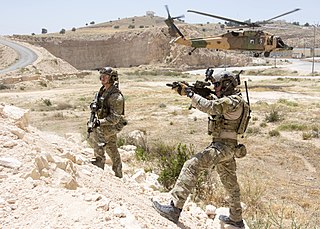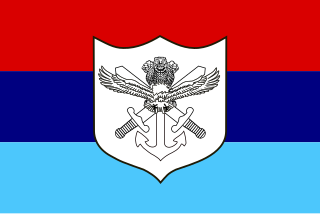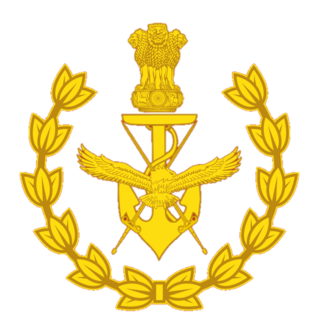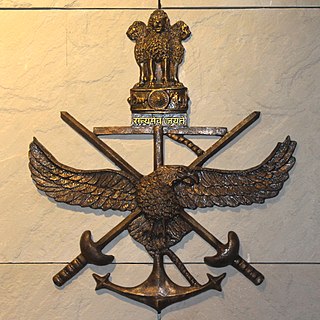
India has several Special Forces (SF) units, with the branches of the Indian Armed Forces having their own separate special forces units. The Indian Army has the Para SF, the Indian Navy has the MARCOS, and the Indian Air Force has the Garud Commando Force. There are other special forces which are not controlled by the military, but operate under civilian organisations, such as the National Security Guard under Home Ministry and Special Group under RAW. Small groups from the military SF units are deputed in the Armed Forces Special Operations Division, a unified command and control structure.

Special operations or special ops are military activities conducted, according to NATO, by "specially designated, organized, selected, trained, and equipped forces using unconventional techniques and modes of employment." Special operations may include reconnaissance, unconventional warfare, and counterterrorism, and are typically conducted by small groups of highly trained personnel, emphasizing sufficiency, stealth, speed, and tactical coordination, commonly known as special forces.
The Strategic Forces Command (SFC), sometimes called Strategic Nuclear Command, forms part of India's Nuclear Command Authority (NCA). It is responsible for the management and administration of the country's tactical and strategic nuclear weapons stockpile. It was created on 4 January 2003 by the Vajpayee Government. Air Marshal Teja Mohan Asthana became its first commander-in-chief.

The Marine Commandos, abbreviated to MARCOS and officially called the Marine Commando Force (MCF), are the special forces of the Indian Navy. The MARCOS were originally named Indian Marine Special Force, which was later changed to Marine Commando Force to impart "an element of individuality" to it, according to the Indian Navy. The abbreviation 'MARCOS' was coined afterwards.
The Nuclear Command Authority (NCA) of India is the authority responsible for command, control and operational decisions regarding India's nuclear weapons programme. It comprises a Political Council headed by the Prime Minister of India and an Executive Council headed by the National Security Advisor.

Para (Special Forces), also known as Para Commandos or Para (SF) Commandos, is a group of special forces battalions of the Parachute Regiment in the Indian Army. These units specialize in various roles including counter-terrorism, hostage rescue, unconventional warfare, special reconnaissance, counter-insurgency and direct action.

The Garud Commando Force is the special forces unit of the Indian Air Force. It was formed in February 2004 and has a current strength of over 1500 personnel. The unit derives its name from Garuda, a Hindu deity.

The Indian Armed Forces are the military forces of the Republic of India. It consists of three professional uniformed services: the Indian Army, Indian Navy, and Indian Air Force. Additionally, the Indian Armed Forces are supported by the Central Armed Police Forces, Indian Coast Guard and Special Frontier Force and various inter-service commands and institutions such as the Strategic Forces Command, the Andaman and Nicobar Command and the Integrated Defence Staff. The President of India is the Supreme Commander of the Indian Armed Forces but the executive authority and responsibility for national security is vested in the Prime Minister of India and their chosen Cabinet Ministers. The Indian Armed Forces are under the management of the Ministry of Defence of the Government of India. With strength of over 1.4 million active personnel, it is the world's second-largest military force and has the world's largest volunteer army. It also has the third-largest defence budget in the world. The Global Firepower Index report lists it as the fourth most-powerful military.
The Andaman and Nicobar Command (ANC) is a integrated tri-services command of the Indian Armed Forces, based at Port Blair in the Andaman and Nicobar Islands, a Union Territory of India. It was created in 2001 to safeguard India's strategic interests in Southeast Asia and the Strait of Malacca by increasing rapid deployment of military assets in the region. It provides logistical and administrative support to naval ships which are sent on deployment to East Asia and the Pacific Ocean.

The Pakistan Army Special Service Group is the special operations forces of the Pakistan Army. They are also known by their nickname of "Maroon Berets" due to their headgear.

In the Indian Armed Forces women are allowed to join in combat service support branches and in non combatant roles only and they can only become officers except the Corps of Military Police of the Indian Army where women can become sepoys too. The Indian Air Force's officer corps had 13.09% women in 2018 and 8.50% in women 2014; the Indian Navy's officer corps had 6% women in 2018 and 3% women in 2014 and the Indian Army's officer corps had 3.80% women in 2018 and 3% women in 2014. In 2020, three officers had the rank of lieutenant-general or equivalent, all in the Medical Services. In May 2021, 83 women were inducted as sepoys for the first time in the Indian Army, in the Corps of Military Police.

The Integrated Defence Staff (IDS) is an organisation responsible for fostering coordination and enabling prioritisation across the different branches of the Indian Armed Forces. It is composed of representatives from the Indian Army, Indian Navy, Indian Air Force, Ministry of External Affairs, Defence Research and Development Organisation, Ministry of Defence and Ministry of Finance. The IDS is headed by Chief of Integrated Defence Staff along with Deputy Chiefs of Integrated Defence Staff. On December 24, 2019, the Cabinet Committee on Security (CCS) established the post of Chief of Defence Staff, a four-star general, a tri-service Chief, that shall lead the defence forces as well as play the role of head of the Department of Military Affairs. The body advises and assists the Chief of Defence Staff.
The Defence Cyber Agency (DCyA) is an integrated tri-services agency of the Indian Armed Forces. Headquartered in New Delhi, the agency is tasked with handling cyber security threats. The DCyA draws personnel from all three branches of the Armed Forces. The head of the DCyA is an officer of two-star rank, and reports to the Chief of Defence Staff (CDS) through the Integrated Defence Staff (IDS).

The Chief of Defence Staff (CDS) is the principal military authority and senior-most appointment of the Indian Armed Forces. Deemed the overall professional head of India’s three armed services, namely, the Indian Army, the Indian Navy and the Indian Air Force, the CDS is the highest-ranking military officer in service, responsible for overseeing inter-service jointness across all disciplines related to military functioning. Primarily, the office operates on a status of primus inter pares i.e., first among equals with the chiefs of the three services, and functions as the Permanent-Chairman of the Chiefs of Staff Committee (COSC) – the inter-service syndicate responsible for ensuring the establishment-cum-preservation of military integration.
Tiger Triumph is the bilateral tri-service amphibious military exercise involving the armed forces of India and the United States. It is the first tri-service military exercise between the two countries. India has previously only held tri-service exercises with Russia.
The Defence Space Agency (DSA) is an integrated tri-services agency of the Indian Armed Forces. Headquartered in Bengaluru, Karnataka, India. The agency is tasked with operating the space-warfare and Satellite Intelligence assets of India. The DSA draws personnel from all three branches of the Armed Forces.

Indian Armed Forces in Jammu and Kashmir encompass the Indian Army, Navy and Air Force, tri-service units such as the Armed Forces Special Operations Division (AFSOD), and paramilitary organisations of the Central Armed Police Forces such as the Border Security Force, the Central Reserve Police Force, the Sashastra Seema Bal and the Indo-Tibetan Border Police. Each three wings of India's military have their special forces deployed in the region including Indian Army's Para SF, the Indian Navy MARCOS and the Indian Air Force's Garud Commando Force. Apart from this, there is the elite police anti-insurgency force in the region, the Special Operations Group, of the Jammu and Kashmir Police.

Integrated Theatre Commands of the Indian Armed Forces are varying degrees of synergy and cross–service cooperation between the military wings of the Indian Armed Forces. Following Independence, in 1949 a joint educational framework was set up starting with the first tri-service academy in the world, the National Defence Academy, and over the years this joint educational framework has been expanded to bring officers from the different services together at different stages of their careers.












